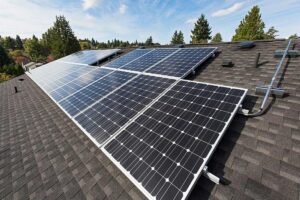A few days ago, the official inauguration of the new photovoltaic solar park took place at the Naval Sub-Officer School (ESSA), in the Partido de Coronel de Marina Leonardo Rosales, in the southern region of the Buenos Aires province. There, the system composed of 369 AMERI SOLAR solar panels, distributed in 22 chains with a maximum generation capacity of 217.8 kW was presented, which generates the necessary energy to cover the energy consumption peaks of the school.
This generated energy is managed through GROWATT smart inverters and panels, which allow the electricity to be automatically injected into the grid and diverted to the Puerto Belgrano Naval Base. This project had a total investment of 195 million pesos, with an average cost of $899 per watt of installed power. Additionally, the system has real-time monitoring, enabling authorized users to have efficient and continuous control.
The inauguration ceremony was attended by Rear Admiral Gustavo Adolfo Principi, General Director of Education of the Navy, along with Navy Captain Marcelo Raúl Rojas, Director of ESSA. Also present were representatives from JL Solar, the company responsible for the project’s execution.
The project was managed by the ESSA Director with technical support from Frigate Captain Alberto Daniel Pericolo, Head of Maintenance Department, and Frigate Captain Eduardo Baliño, Head of Electrical Services Department at the Puerto Belgrano Naval Base. Both led the development of the technical specifications and supervised the installation process.

Project Development
The project of the new photovoltaic solar park began in 2023 with an electricity consumption survey, led by ESSA personnel. This analysis concluded with the technical report titled “Energy Efficiency Study in the Naval Sub-Officer School buildings”, which served as the basis for drafting the project descriptive document: “Improvement of the power supply network through the installation of solar energy equipment”.
The tender was awarded to JL Solar, a company from Bahía Blanca, on October 4, 2024. After a testing period that will end in December 2024, the solar park will enter full operation.
This new system not only ensures a more flexible power supply for the ESSA buildings but also represents a significant step towards institutional sustainability. “The solar park will notably reduce the School’s carbon footprint,” they highlighted during the event.
 solar panels
solar panels
Neuquén will build the largest solar park in Patagonia in 2025
The mayor of Neuquén city, Mariano Gaido, the governor Rolando Figueroa, and the president of CALF, Marcelo Severini, are preparing to officially announce the project of the largest solar park in Patagonia, an initiative that is part of the city’s commitment to sustainable development. In this regard, they revealed that the construction of this park will start in 2025.
According to the project stakeholders, the official presentation will take place between late November and early December this year. This park will be located on a 100-hectare land within the urban expansion of Neuquén with the aim of generating electrical energy from a renewable source, photovoltaic energy. They ensure that its capacity will be equivalent to a quarter of the energy currently consumed by the entire city of Neuquén.
As explained by Gaido, the municipality will provide the land for the project, while CALF, under Severini’s leadership, will be in charge of the executive project development and the preparation of the bidding specifications for the park’s construction. “It will be the first one with an installed power of 50 megawatts, and the largest in Patagonia, placing Neuquén at the forefront of the fight against climate change,” stated the mayor of the provincial capital.
Do you already know our YouTube channel? Subscribe!

